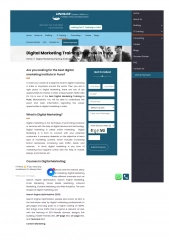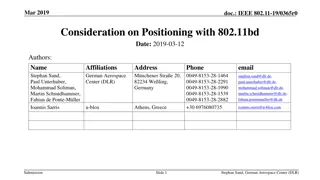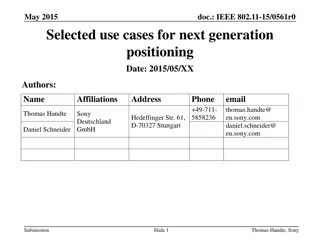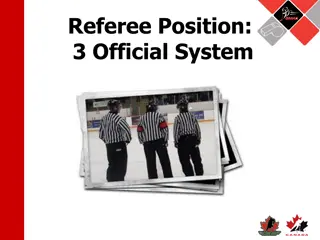Advanced Marketing Management: Differentiation and Positioning
Consumers make purchasing decisions based on product differentiation and positioning in marketing, focusing on creating unique value propositions. Learn about how brands differentiate themselves and position their products to stand out in the market.
Download Presentation

Please find below an Image/Link to download the presentation.
The content on the website is provided AS IS for your information and personal use only. It may not be sold, licensed, or shared on other websites without obtaining consent from the author.If you encounter any issues during the download, it is possible that the publisher has removed the file from their server.
You are allowed to download the files provided on this website for personal or commercial use, subject to the condition that they are used lawfully. All files are the property of their respective owners.
The content on the website is provided AS IS for your information and personal use only. It may not be sold, licensed, or shared on other websites without obtaining consent from the author.
E N D
Presentation Transcript
ADVANCED MARKETING MANAGEMENT DIFFERENTIATION AND DIFFERENTIATION AND POSITIONING POSITIONING PRESENTED BY DR. UMA SHANKAR SINGH FACULTY OF ADMINISTRATIVE SCIENCE AND ECONOMICS ISHIK UNIVERSITY
Instructions Objective: To know the differentiation and positioning in marketing . Dos :Ask questions. Supplement or complement with learning. : Break silence and discipline. Don ts Ring phones. Talk friends. 2025/2/16 2 AMM WEEK 4
Differentiation Consumers or organizational customers choose what they buy for one of two reasons: What they choose is better. What they choose is cheaper. In either case, the choice is, in some way, almost always different from others they could have chosen.
Differentiation Most of the time, differentiation is why people buy. Differentiation among competing brands Differences can be physical or perceptual. Brand positioning seeks to create both physical and perceptual differences using all the elements of the marketing mix.
Product Position The way the product is defined by consumers on important attributes--the place the product occupied in consumers minds relative to competing products. Products are created in the factory, but brands are created in the mind.
Product Position Samples Tide: a powerful, all-purpose family detergent Ivory: the gentle detergent for fine washables and baby clothes. Subway restaurants: eat fresh
Product Position Samples Nissan March and Honda Jazz: economy Mercedes and Cadillac: luxury
Product Position Samples Porsche and BMW: performance Volvo: safety
Product Position Samples Toyota s fuel-efficient Hybrid Prius: high-tech solution to the energy shortage
Product Position Consumers position products with or without the help of marketers. Marketers must Plan positions that will give their products the greatest advantage in selected target markets Design marketing mixes (4Ps) to create these planned positions.
Physical Positioning Physical positioning analysis can provide useful information in the early stages of identifying and designing new product offerings. Based primarily on technical rather than on market data Physical comparisons can be an essential step in undertaking a positioning analysis.
Physical Positioning Limitations A comparison of the physical dimensions does not provide a complete picture of relative positions. Customers attitudes toward a product are often based on social or psychological attributes not amenable to objective comparison. Consequently, perceptual positioning analysis is critically important.
Positioning Maps Perceptual positioning maps show consumer perceptions of their brands versus competing products on important buying dimensions. Important buying dimension: Price Quality Service environment/ location Choice of products/services Etc.
Perceptual Positioning Consumers often know very little about the essential physical attributes of the brands they buy. The same is true for many services. Even if they did, they might not understand the physical attributes well enough to use them as a basis for choosing between competitive offerings.
Perceptual Positioning A consumer can typically evaluate a product better on the basis of benefits it provides. The evaluation of many goods and services is subjective.
Positioning Map U.S. Large Luxury Sport Utility Vehicle Market *Location of each circle shows where consumers position a brand on two dimensions: price and luxury- performance orientation. 160 Escalade Escalade ESV Hummer H1 Hummer H2 Infiniti QX56 Range Rover Lexus LX470 Navigator Land Cruiser 120 Price (thousands of $) 80 *Size for each circle indicates the brand s relative market share in the segment. 40 luxury Performance Orientation
Choosing a Differentiation and Positioning Strategy A brand s positioning must serve the needs and preferences of well-defined target markets.
Choosing a Differentiation and Positioning Strategy 3 steps of differentiation and positioning task: 1) Identifying a set of differentiating competitive advantages upon which to build a position 2) Choosing the right competitive advantages 3) Selecting an overall positioning strategy Then the company must effectively communicate and deliver the chosen position to the market.
Differences and Competitive Advantages Competitive Advantage: an advantage over competitors gained by offering greater customer value, either through lower prices or by providing more benefits that justify higher prices.
Differences and Competitive Advantages To find points of differentiation, marketers must think through the customer s entire experience with the company s product or service. It can differentiate along the line of product, services, channels, people, or image.
Product Differentiation Brands can be differentiated on features, performance, or style and design. Bose positions its speakers on the striking design and sound characteristics. Panasonic positions its Toughbook PCs, designed to stand up to rugged use on the road or in the field, as durable, reliable, wireless protect your work no matter where you work.
Service Differentiation Some companies gain service differentiation through speedy, convenient, or careful delivery. TD Bank has positioned itself as the most convenient bank in America it remains access to the bank 24 hours a day, 7 days a week. TD Bank, America's Most Convenient Bank
Channel Differentiation Firms that practice channel differentiation gain competitive advantage through the way they design their channel s coverage, expertise, and performance. Amazon.com and GEICO set themselves apart with their smooth functioning direct channels.
People Differentiation Companies can hire and train better people than their competitors do. People differentiation requires company select its customer-contact people carefully and train them well. Singapore Airlines has an excellent reputation, largely because of the grace of its flight attendants. Singapore Airlines
Image Differentiation A company brand image should convey the product s distinctive benefits and positioning. Developing a strong and distinctive image cannot do overnight using a few advertisements.
2) Choosing the Right Competitive Advantages How Many Differences to Promote? Many marketers think that companies should aggressively promote only one benefit (unique selling proposition: USP) to the target market. Buyers tend to remember number one better, esp. in this overcommunicated society.
2) Choosing the Right Competitive Advantages Which Differences to Promote? Not every difference make a good differentiator. Each difference has the potential to create company costs as well as customer benefits.
2) Choosing the Right Competitive Advantages Which Differences to Promote? A difference is worth establishing to extent that it satisfies the following criteria: Important: the difference delivers a highly valued benefit to target buyers Distinctive: competitors don t offer the difference, or company can offer it in a more distinctive way. Superior: the difference is superior to other ways that customers might obtain the same benefit.
2) Choosing the Right Competitive Advantages Which Differences to Promote? A difference is worth establishing to extent that it satisfies the following criteria: Communicable: the difference is communicable and visible to buyers Preemptive: competitors can t easily copy the difference. Affordable: Buyers can afford to pay for the difference. Profitable: the company can introduce the difference profitably.
3) Selecting an Overall Positioning Strategy Value proposition: the full positioning of a brand the full mix of benefits upon which it is positioned. It is the answer to the customer s question why should I buy your brand? Volvo s value proposition: safety also include reliability, roominess, and styling, all for a price that is higher than average but seems fair for this mix of benefits.
Developing a Positioning Statement Positioning statement: A statement that summarizes company or brand positioning it takes this form: To (target segment and need) our (brand) is (concept) that (point-of-difference).
Developing a Positioning Statement State the product s membership in a category Positioning statement sample: To busy, mobile professionals who need to always be in the loop, Blackberry is a wireless connectivity solution that gives you an easier, more reliable way to stay connected to data, people, and resources while on the go. Show its point of difference from other members of the category
Communicating and Delivering the Chosen Position Positioning the company calls for concrete action, not just talk. If the company decides to build a position on better quality and service, it must deliver that position.
Levers Marketers Can Use to Establish Brand Positioning Marketing decision makers seek to endow their brand with various kinds of attributes: Simple physically based attributes. Complex physically based attributes. Essentially abstract attributes. Price. Perceptual attributes must be considered in positioning most products.
The Brand Positioning Process Step 1: Identify a relevant set of competitive products A positioning analysis at the product or brand level can be helpful. Marketers who omit important substitute products or potential competitors risk being blindsided by unforeseen competition.
The Brand Positioning Process Step 2: Identify determinant attributes Positioning can be based on a variety of attributes: Features, benefits, parentage, manufacturing process, ingredients, endorsements, comparison with a competitor s product, proenvironment positioning, and price/quality. Marketers should rely primarily on determinant attributes.
The Brand Positioning Process Step 3: Collect data about customers perceptions for brands in the competitive set The marketer needs to know what attributes are determinant for the target market and the product category under consideration. The marketer also needs to know how different brands in the competitive set are viewed on these attributes.
The Brand Positioning Process Step 4: Analyze the current positions of products in the competitive set The positioning grid, also called a perceptual map provides a visual representation of the positions of various products or brands in the competitive set in terms of two determinant attributes. Value curve comprises more than just two dimensions.
The Brand Positioning Process Building a positioning grid Positioning for a new store could be done by examining the positioning map for empty spaces (competitive gaps) where no existing store is currently located . Building a value curve Value curves indicate how products within a category compare in terms of the level high or low. Value curves are more multidimensional
Perceptual Map of Womens Clothing Retailers in Washington, D.C.
The Brand Positioning Process Marketing opportunities to gain a distinct position Competing head-on against the leaders on the basis of attributes appropriated by larger competitors is not likely to be effective. A better option is to concentrate on an attribute prized by members of a given market segment.
The Brand Positioning Process Constraints imposed by an intense position Threat of alienating part or all of the product s current users regardless of success with its newly targeted group. Dilution of an existing intense position as a result of consolidation. Temptation to overexploit the position by using the brand name on line extensions and new products.
The Brand Positioning Process Limitations of product positioning analysis It does not tell the marketer which positions are most appealing to customers. There is no way to determine if there is a market for a new brand or store. To solve such problems it is necessary to measure customers preferences and locate them in the product space along with their perceptions of the positions of existing brands. This is called a market positioning analysis.
The Brand Positioning Process Step 5: Determine customers most preferred combination of attributes Survey respondents can be asked to think of the ideal brand within a category. Respondents could be asked not only to judge the degree of similarity among pairs of existing brands but also to indicate their degree of preference for each. Conjoint analysis
The Brand Positioning Process Step 6: Consider fit of possible positions with customer needs and segment attractiveness A market positioning analysis can simultaneously identify distinct market segments as well as the perceived positions of different brands.
The Brand Positioning Process By examining the preferences of customers in different segments along with their perceptions of the positions of existing brands, analysts can learn much about: The competitive strength of different brands in different segments. The intensity of the rivalry between brands in a given segment. The opportunities for gaining a differentiated position within a specific target segment.
The Brand Positioning Process Step 7: Write positioning statement or value proposition to guide development of marketing strategy A positioning statement identifies the target market for which the product is intended and the product category in which it competes and states the unique benefit. A value proposition is similarly explicit about what the product does for the customer and typically also includes information about pricing relative to competitors.
The Brand Positioning Process Both positioning statements and value propositions should generally reflect a unique selling proposition (USP) that the product embodies. In its shortest form, a value proposition typically looks like this: Target market Benefits offered (and not offered) Price range (relative to competitors)
The Brand Positioning Process Positioning statement or value proposition should state benefits that the user of the product will obtain, rather than features or attributes of the product itself. Typically not written in catchy consumer language.























